skip to main |
skip to sidebar
Click on any picture below to see 'uncropped' versions, or explore using the links in 'My Pictures' below.
Introduction
Liverpool has alway had a fascination for me which I mentioned in a 2009 post Liverpool and subsequent posts about the railways. In the post By rail to Liverpool (Part 1), I described my journey on Saturday, 8th March 2014 via the former Great Western and former Great Central lines to Bidston station, on the Wirral. This post describes my travels from Bidston that day.
By Merseyrail from Bidston
Despite the roar of traffic from the nearby elevated M53 motorway, Bidston manages to give a very rural impression, surrounded by greenery, a lot of it no doubt where nature has taken back the land after the extensive goods sidings were removed. From earlier visits, I remember Bidston Dee Jn. signal box, a 65-lever L.M.S. construction facing the platform. That's now gone - most of the Merseyrail network is now controlled from Sandhills Control Centre. By the time I'd purchased my Merseyrail ticket, a train from West Kirby was arriving, headed for Liverpool Central and, although it was already crowded, I decided to board. This meant deferring a trip to West Kirby until another visit. Shortly after the train left Bidston, the line from New Brighton converged on our left and I was now retracing the route I'd last used on my trip on 8th February 2014 (described here). When we stopped at Birkenhead North, I was amazed to find major progress on the new footbridge incorporating lifts for disabled access.
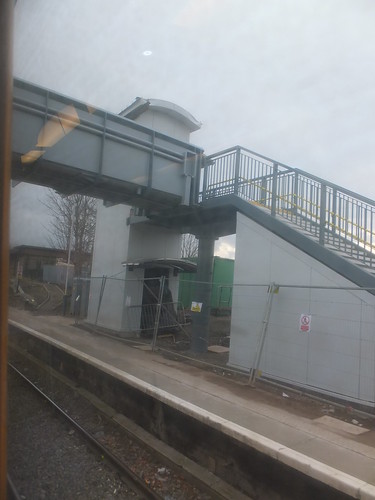
The new footbridge under construction at Birkenhead North.
I had toyed with the idea of getting off at Birkenhead Park. This was originally the end-on junction between the Mersey Railway and the Wirral Railway and provided with four platforms. Until the L.M.S. electrified the Wirall Railway lines, through passengers had to change between electric and steam trains and it must have been a busy place. Now, it's reduced to a single island platform between Up and Down lines, with steps leading up to station buildings on the road overbridge. The road is Duke Street, which, further north, divides the West Float and East Float as I described in my earlier post. Anxious to make the most of my limited time, I abandoned the idea of getting off and stayed on the even more crowded train as it called at Conway Park and Hamilton Square.
After Hamilton Square, we passed under the River Mersey using the first tunnel built under the Mersey. There's a little more about the tunnel-building in my post here. I still find it hard to believe that from 1886 to 1903, the trains through the tunnel were worked by steam traction.
Liverpool
The first station on the Liverpool side of the river is James Street and, originally, the line continued to an underground terminus at Liverpool Central, as shown in my post here. In 1977, British Railways opened the underground 'Liverpool Loop' and now, after James Street, trains call at Moorfields, Lime Street and Central, before re-appearing at James Street heading in the opposite direction.
I left the train at Central and escalators took me to the surface. It's a modern station but I found it quite pleasant, even at lunchtime on a Saturday when it appears that everyone wants to travel. A particularly civilised detail was the clean, free toilets so I emerged into the streets in a fairly relaxed mood.
A Walk through Liverpool
I'd initially intended to continue my journey by train but the streets were busy with apparently good-natured pedestrians and the weather was dry for a while, so I decided to stay 'topside'. Feeling peckish, I bought takeaway fish cake and chips at a small, scrupulously clean cafe and sat at a nearby junction where there were lots of seats and litter bins and enjoyed my food while I watched the shoppers go by.
I admired what I afterwards discovered was only the modest side elevation of the Lyceum. The neo-classical Lyceum was designed by the architect Thomas Harrison from Chester following an open competition with the local Liverpool architect John Foster (Surveyor to the Corporation of Liverpool). The Lyceum was built between 1800 and 1802 and has a colonnaded front facing Bold Street which I didn't study on this trip. The building has served various functions over the years (including Post Office) but is largely unused at present and the owner's of the Grade II Listed Building are seeking a new tenant or a sale. The Waterloo Place facade which caught my attention has four Ionic columns with three relief panels by F.A. Lege. Once, this facade housed the entrance to the Library and Newsroom, now it's the Co-operative Bank (or 'The co-oper.tive b.nk' as the sign declared. Perhaps there's a ready market for stolen letter 'a'?).
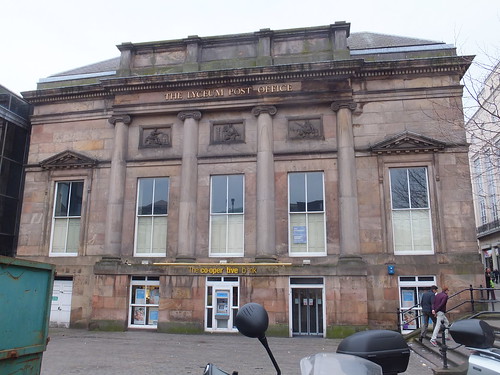 The Waterloo Place facade of the Lyceum.
The Waterloo Place facade of the Lyceum.
Having finished my meal, I decided to walk through the city to Pierhead, with the idea of using the Mersey Ferry to cross back to the Birkenhead side. My route took me through the pedestrianised Church Street, then Lord Street and Derby Square (where there's an elaborate memorial to Queen Victoria).
 Victoria Memorial, Derby Square.
Victoria Memorial, Derby Square.
I continued down James Street, passing the Merseyrail Station on the right, with its bus stop outside for easy interchange. I approve of the attempt at an integrated transport system, but the ugliness of the associated street furniture and station facade contrasts sharply with the pleasing appearance of the Mersey Tunnel Pumping Station, framed against a background of acres of unrelieved black glass of the Mann Island modern development.
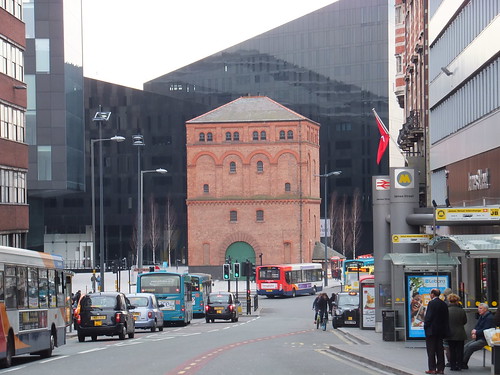 Looking down James Street, the black glass of the modern developments highlights the clean lines of the Mersey Railway Pumping Station, still at work.
Looking down James Street, the black glass of the modern developments highlights the clean lines of the Mersey Railway Pumping Station, still at work.
Then I crossed the wide dual-carriageway of Strand Street and passed the ventilating shaft and associated offices of the Mersey Road Tunnel. The architectural style is not my favourite but the sense of proportion lends a satisfying dignity quite missing from much modern work (like the black glass Mann Island development mentioned above).

Mersey Road tunnel ventilating shaft and offices.
The Museum of Liverpool
There remained time to make a very brief visit to The Museum of Liverpool (part of Liverpool Museums) just to check on the centre piece of the 'Great Port' Gallery - the locomotive 'Lion'.
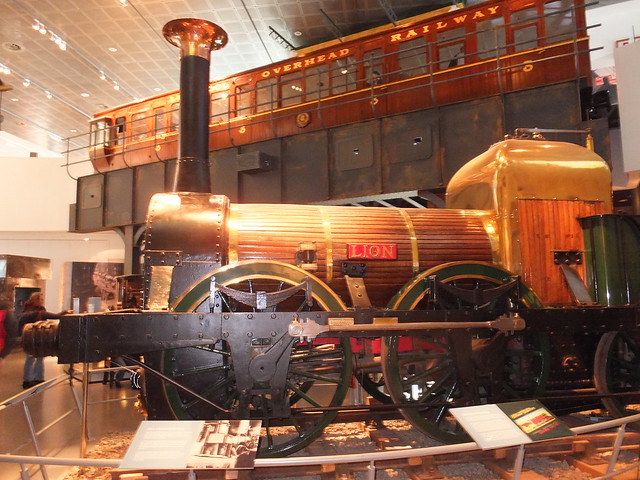 'Lion' on display in the Great Port Gallery, with the Liverpool Overhead Railway coach in the background.
'Lion' on display in the Great Port Gallery, with the Liverpool Overhead Railway coach in the background.
I'm still secretary of the Old Locomotive Committee (the 'Lion' supporters club) and I've written a number of posts which are here. But I don't think I'll ever grow to love the 21st century architecture of this museum on a World Heritage Site designed by the Danish architects 3XN. Originally 'Nielsen, Nielsen and Nielsen', they became '3 x Nielsen' and then '3XN'.
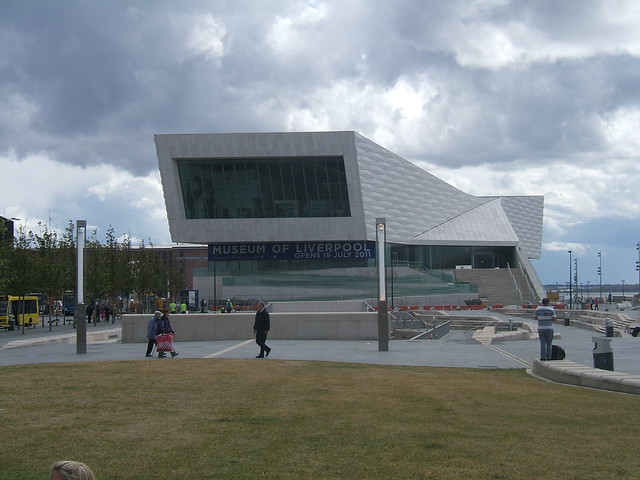 The Museum of Liverpool shortly before opening to the public in 2011 - "Fourth Grace" or "Dented Shoebox"?
The Museum of Liverpool shortly before opening to the public in 2011 - "Fourth Grace" or "Dented Shoebox"?
Ferry Cross the Mersey
Then on to Georges Pierhead and the Booking Office for the Mersey Ferry. This is another modern building suffering the same affliction as the Museum of Liverpool and the Mann Island Developments - a morbid fear of the Right Angle. But the Staff were friendly and, clutching my Boarding Pass, I was soon making my way outside to await the arrival of the Mersey Ferry 'SNOWDROP'.
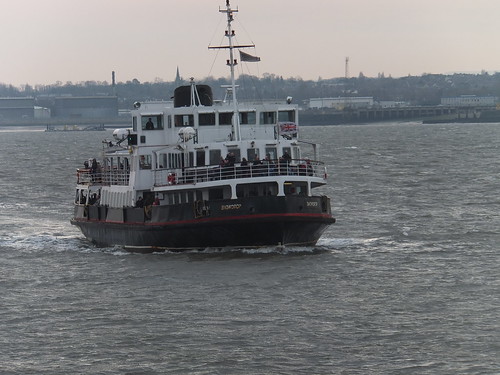 Mersey Ferry 'Snowdrop' approaching Pierhead.
Mersey Ferry 'Snowdrop' approaching Pierhead.
The ferry leaves Pierhead 'on the hour', calling first at Seacombe and then Woodside before returning to Pierhead for the next trip. With a well-loaded ferry, we were under way right time.
This time, there was no Cruise Ship at the adjacent terminal but, instead, the rather threatening bulk of HMS Dragon - a Type 45 'Daring' class Air Defence Destroyer. You can learn more on Wikipedia here or the Royal Navy site here.
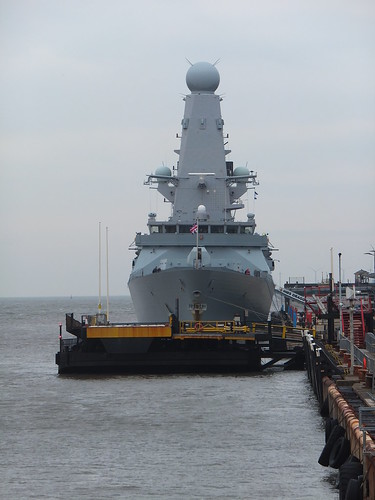
HMS Dragon is a Type 45 'Daring' class Air Defence Destroyer, seen making a weekend visit to Liverpool.
The sun was bright but there was a strong wind. Within a few minutes, the ferry was berthing at Seacombe. The Captain and First Officer were relieved by two more men, presumably just starting an afternoon 'watch'. There was a little pantomime when the gangway was raised before it was realised that the relieved men were still aboard, so the gangway had to be lowered again to let them disembark.
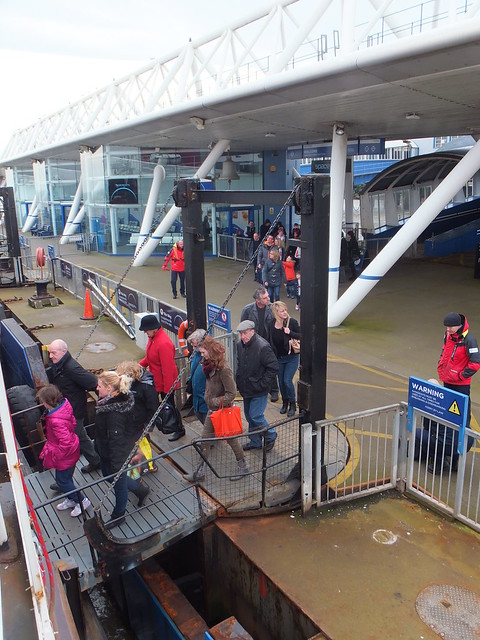
Passengers boarding at Seacombe Landing Stage.
The ferry then continued upstream to Woodside Landing Stage, passing the lock gates giving access to Birkenhead Great Float and Stena Line's 12 Quays Terminal where the Isle of Man ferry 'Ben-My-Chree' was berthed. This ferry is described in Wikipedia here.
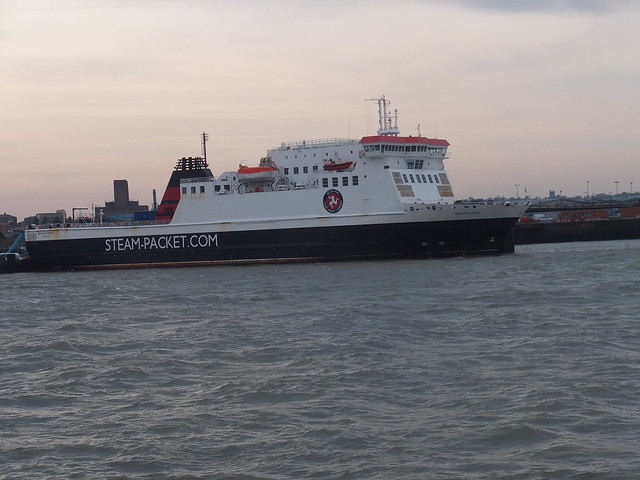 Isle of Man ferry 'Ben-My-Chree'.
Isle of Man ferry 'Ben-My-Chree'.
Birkenhead Briefly
I disembarked at Woodside and walked to Hamilton Square Station, passing the Mersey Railway Pumping Station at Shore Road. This is similar in appearance to the one on the Liverpool side (mentioned above) but larger. Although electric pumps now do the work, the original steam pump, 'The Giant Grasshopper' is still in situ. A few years ago, I was able to visit and see the pump operating (using air, not steam) but I believe it's closed at present because of financial constraints.
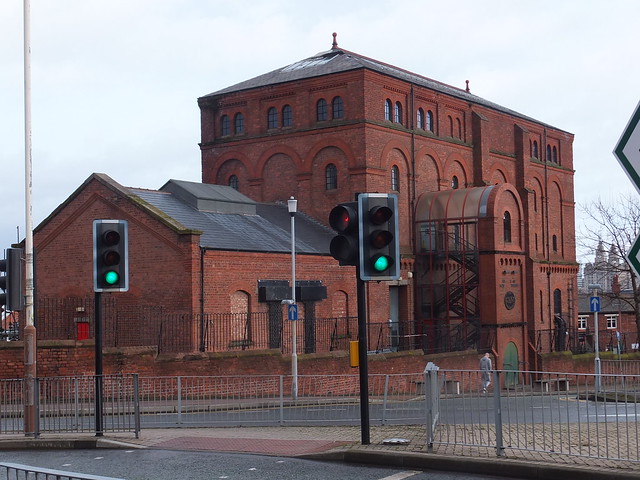 Birkenhead: Pumphouse with 'The Giant Grasshopper' pump.
Birkenhead: Pumphouse with 'The Giant Grasshopper' pump.
Entering Hamilton Square Station, I took the lift to Platform Level and caught the first train towards Chester, on the route I'd travelled on 8th February 2014, described in the post here.
I decided to alight at Bebington station and pay a visit to the Lady Lever Art Gallery at Port Sunlight. Bebington was formerly on a four-track route paired by use, with one island platform flanked by single platforms either side. A subway provided access to the platforms. Merseyrail now uses only the old slow lines, so the subway ramp I took leaving the station originally served the island platform.
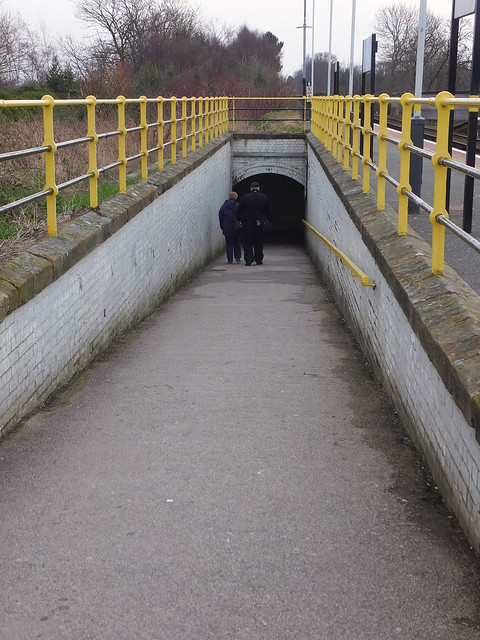
Mersey rail: Access ramp at Bebington Station.
Lady Lever Art Gallery
In the post Birkenhead and New Brighton by train (Part 1) I wrote a little about Port Sunlight. I'm afraid I found the Model Village rather 'twee', although I admire William Lever's intentions. In a real village, a clash of building styles over time can be attractive but when each block deliberately differs from its neighbour in a self-conscious manner, as here, I'm not so sure.
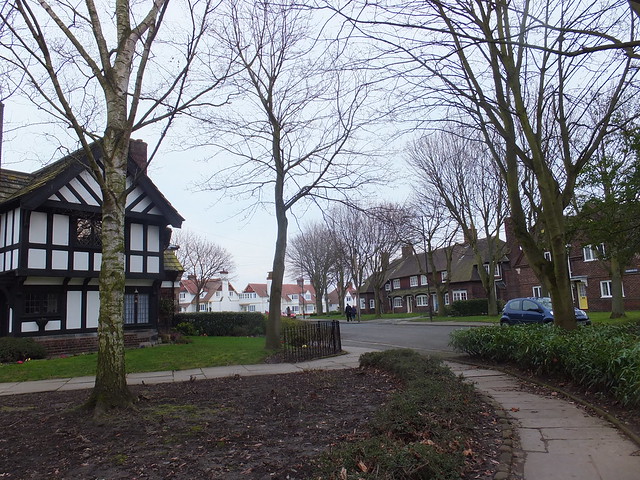 Port Sunlight, showing varying building styles.
Port Sunlight, showing varying building styles.
A ten-minute walk from the station took me to the Lady Lever Art Gallery. The Gallery was opened in 1922 by William Lever (by then the First Viscount Leverhulme) and named in memory of his wife Elizabeth. It was designed by architects William and Segar Owen from Warrington and is now Listed Grade II.
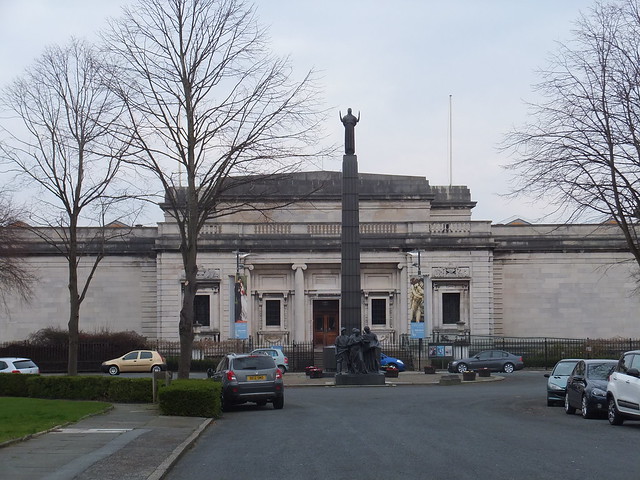 The Main entrance to the Lady Lever Art Gallery.
The Main entrance to the Lady Lever Art Gallery.
The Collection was always intended for public display, not as a rich man's private pleasure. Lady Lever Art Gallery claims it "houses one of the UK’s finest collections of fine and decorative art. It has the best collection of Wedgewood jasperware anywhere in the world and its collection of Pre-Raphaelite paintings is internationally renowned". Display is fairly traditional and certainly worked for me. I was enchanted by the place.
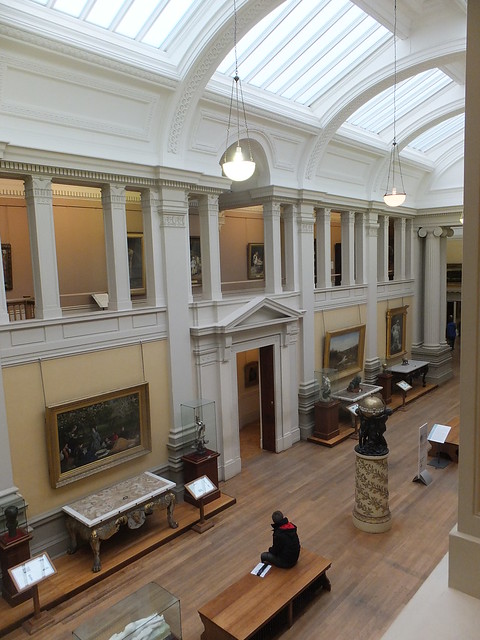
View of the Main Hall from the East Balcony Gallery.
The Art Gallery is now part of Liverpool Museums and the contrast with the Museum of Liverpool I'd visited earlier could hardly be more pronounced.
The Lady Lever Art Gallery has a special exhibition of the works of J.M.W. Turner until 1st June 2014. I was able to study around 30 works from different periods of his life during my visit.
The Journey Home
I walked back to Bebington Station to catch the next train south. This was an Ellesmere Port train and, at first, I intended to travel to Ellesmere Port. However, during the journey, I decided that I'd had enough adventures for one day so I 'bailed out' at Hooton and transferred to the following Chester train.
At Chester, my onward connection was from the platform 2 bay. We took the North Wales Coast route to Saltney Junction where we turned left onto the (now singled) former Great Western line to Wrexham. At Wrexham General, we were back on double track and I rejoined the route out I'd taken that morning.
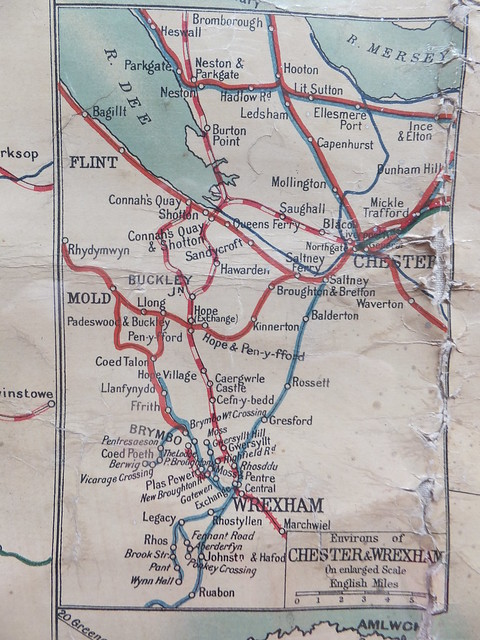 'Environs of Chester & Wrexham' from the 11th Edition of the Pre-Grouping 'Railway Map of England and Wales' published by W & A K Johnston.
'Environs of Chester & Wrexham' from the 11th Edition of the Pre-Grouping 'Railway Map of England and Wales' published by W & A K Johnston.
The train from Chester took me as far as Shrewsbury where I alighted on platform 4. The train then continued - for Cardiff, I think, but I was quite tired by this time and not paying attention. The next arrival on platform 4 was my connection, arriving from Aberystwyth (I think) and reversing before going on to Birmingham International, allowing me to get off at Wolverhampton.
Another excellent (if exhausting) day trip.
Book references
[1] 'An Illustrated History of Liverpool's Railways' by Paul Anderson, published Irwell Press (ISBN 1-871608-68-6).
[2] 'A Regional History of the Railways of Great Britain': Volume 10 The North West by G. O. Holt, Second Edition published by David & Charles (ISBN 0946537 34 8).
Related posts on this site
By rail to Liverpool (Part 1)
Early Days of the Mersey Railway.
Birkenhead and New Brighton by train (Part 1)
Birkenhead and New Brighton by train (Part 2)
Birkenhead and New Brighton by train (Part 3)
Railways around Birkenhead
My pictures
Merseyrail.
Liverpool.
Museum of Liverpool.
Port Sunlight, Wirral.
This report is based on information from Doctor Hla Tun, who also supplied the photographs.
The Bagan Clinic treated 2,881 patients in February 2014, bringing the total number of treatments since the Clinic opened on 6th August 2011 to 97,938.
Treatment Summary
The table below summarises the number of treatments per month in 2013 and the total number of treatments since the clinic opened on August 6, 2011.
| Month |
Patients treated |
Total treatments |
| February 2013 |
2,713 |
49,850 |
| March 2013 |
2,713 |
49,850 |
| April 2013 |
2,061 |
54,924 |
| May 2013 |
3,303 |
58,227 |
| June 2013 |
5,586 |
63,813 |
| July 2013 |
6,079 |
69,892 |
| August 2013 |
5,337 |
75,229 |
| September 2013 |
4,826 |
80,055 |
| October 2013 |
3,647 |
83,702 |
| November 2013 |
4,465 |
88,167 |
| December 2013 |
3,387 |
91,554 |
| January 2014 |
3,501 |
95,057 |
| February 2014 |
2,881 |
97,938 |
Monthly notes
The New Clinic Building was brought into use on 14th February 2014 as a temporary Physiotherapy Unit until the building of a permanent Physiotherapy Unit is completed. The majority of patients attending can benefit from physiotherapy, having suffered strokes, joint pains and muscular pains. Treatments include Infra Red, Ultrasound, Traction Machine, Electric Massage and Handrails for patients with walking difficulty.
 New Clinic building in use as a temporary Physiotherapy Unit.
New Clinic building in use as a temporary Physiotherapy Unit.
Building work has already started on a permanent Physiotherapy Unit building near the original Clinic building. The building has been donated by a United Kingdom Travel Company and their clients.
 New Physiotherapy Unit under construction near the Clinic.
New Physiotherapy Unit under construction near the Clinic.
Few of the patients treated are from the local area. The majority of patients have to travel distances up to 250km. This means that most patients need to stay in the Monastery Compound for one or two nights. On clinic days, shelter is also needed by patients waiting for attention. The United Kingdom Travel Company and their clients mentioned above have also funded the building of a new Accommodation Shelter.
 New Accommodation Shelter under construction.
New Accommodation Shelter under construction.
There are a number of posts in this Blog on medical support in Myanmar provided by the RTM Social Contribution with help from donors around the world. You can find them all here.
This report is based on information from Doctor Hla Tun, who also supplied the photographs.
The Bagan Clinic treated 3,387 patients in December 2013 and 3,501 patients in January 2014 bringing the total number of treatments since the Clinic opened on 6th August 2011 to 95,057.
Treatment Summary
The table below summarises the number of treatments per month in 2013 and the total number of treatments since the clinic opened on August 6, 2011.
| Month |
Patients treated |
Total treatments |
| February 2013 |
2,713 |
49,850 |
| March 2013 |
2,713 |
49,850 |
| April 2013 |
2,061 |
54,924 |
| May 2013 |
3,303 |
58,227 |
| June 2013 |
5,586 |
63,813 |
| July 2013 |
6,079 |
69,892 |
| August 2013 |
5,337 |
75,229 |
| September 2013 |
4,826 |
80,055 |
| October 2013 |
3,647 |
83,702 |
| November 2013 |
4,465 |
88,167 |
| December 2013 |
3,387 |
91,554 |
| January 2014 |
3,501 |
95,057 |
Monthly notes
The existing toilets were proving inadequate for the numbers of patients attending the Clinic but a local donor agreed to pay for a further 6 cubicles, helping to maintain a sanitary environment around the Clinic. The picture below shows the new facilities nearing completion.
 New toilet block under construction at the Bagan Clinic.
New toilet block under construction at the Bagan Clinic.
On 14-Feb-2014 (Valentine's Day), about 82 pairs of reading glasses were distributed to patients over 60 years of age. There was no opthalmologist in attendance so, as previously, each patient selected a suitable pair by trial-and-error, reading a newspaper or the medical record book (issued by the Clinic to all patients).
 Elderly patients choosing reading glasses by trial-and-error.
Elderly patients choosing reading glasses by trial-and-error.
Local patients from the Bagan area represent less than 5% of patients attending. Patients travel anything from 30km to 250km to seek treatment. This involves staying one or two nights in the Monastery Compound and a new accommodation shelter for waiting patients is being constructed near the Clinic. The age range of patients varies from babies as young as 2 months old to elderly people over 80.
With the support of the Head Monk and the 'Road to Mandalay' river cruise ship, on Fridays and Saturdays up to 300 free lunches are given to waiting patients and their companions at 11:40. When possible, free dinners are also offered at 17:45 hours on Saturdays.
 Distribution of free lunches.
Distribution of free lunches.
There are a number of posts in this Blog on medical support in Myanmar provided by the RTM Social Contribution with help from donors around the world. You can find them all here.
Introduction
Liverpool has always had a fascination for me and there are a number of posts in this blog about Merseyside and the Wirral, starting with the 2009 post Liverpool.
Although most of my trips to Liverpool are undocumented, a few of my journeys are outlined in this blog. I've written about various journeys by train via Crewe:-
'Black 5' to Birmingham (1950s steam).
Day Trip to Liverpool (2010 EMU).
Liverpool by Train (2012 EMU).
On Saturday, 8th March 2014 I decide to make another trip to Liverpool, this time by a more unusual route.
I started by re-tracing the route I'd used on my earlier trip to Chirk, described here. Once again, this involved taking an Arriva DMU from Wolverhampton to Shrewsbury, using a 'semi-fast' train only stopping at Telford and Wellington.
Shrewsbury
At Shrewsbury, I planned to change onto an Arriva Trains Wales service from Cardiff to Holyhead. The train was reported as a few minutes late and I was surprised to find that it would use platform 3, which I didn't think was much used. Getting to platform 3 was a bit odd. We'd arrived on bay 5 which is part of the island platform comprising through platforms 4 and 7 together with bays 5 and 6. Exit from this island platform was via broad stairs down to a subway leading to a series of automatic ticket barriers. Access to platform 3 wasn't obvious but a ticket inspector at the barrier seemed to be letting some passengers through. When I enquired, he waved me through, telling me to pass through the ticket hall, turn left and go up the stairs. The small ticket hall was thronged with passengers entering and leaving but I was reassured by a sign pointing left to platform 3. I continued onto the station forecourt, puzzled for a moment until I saw an anonymous set of open double doors with steps leading upwards. It was rather confusing but I'd apparently found platform 3.
 The imposing ashlar-faced facade of Shrewsbury station, viewed from the forecourt.
The imposing ashlar-faced facade of Shrewsbury station, viewed from the forecourt.
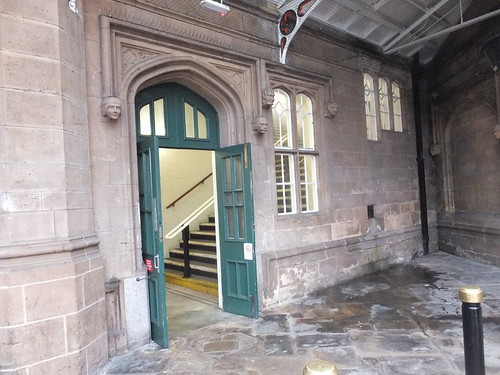 The impressive, but rather anonymous, entrance to platform 3 from the forecourt.
The impressive, but rather anonymous, entrance to platform 3 from the forecourt.
The train was a few minutes late so I still had time for a few photographs. The design of the station building on platform 3 (the earliest part of the station) I found most attractive. The detailing I'd found on the elevation facing the forecourt is continued on the platform face. It was no surprise to find the building listed Grade II, but I was surprised to find it was by Thomas Penson Junior, whose station at Gobowen (in Italianate style) I'd previously admired. See the entry on the British Listed Buildings site.
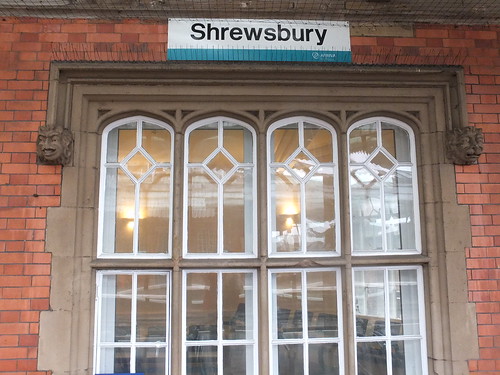 Window to waiting room on platform 3.
Window to waiting room on platform 3.
 Crewe Junction, Shrewsbury, viewed from platform 3.
Crewe Junction, Shrewsbury, viewed from platform 3.
The train arrived, people alighted and boarded and we departed with a well-filled train about ten minutes late. On this trip, I managed a (rather poor) shot of Coton Hill North Signal Box, long disused and converted into a private house with modern extensions to one side and at the rear.
 Coton Hill North Signal Box now forms part of a private house.
Coton Hill North Signal Box now forms part of a private house.
Gobowen
Approaching Gobowen, I was a little surprised to pass a modern LED signal displaying a double yellow, followed by another LED signal showing single yellow. I assumed that the intention was to give drivers the best possible warning before the semaphore signal protecting the level crossing at the north end of the platform. At Gobowen, a remarkable number of passengers got off and got on whilst I, once again, admired the Italianate station building by Thomas Penson Junior. I also wondered whether the semaphore signal protecting the level crossing was the ugliest semaphore I'd seen (there's some heavy competition from some of the signals in Burma - see Railway Signalling in Burma - Part 1: Semaphore Signals). A tubular post topped with a Western Region 'ball and spike' finial is fitted with an upper quadrant arm at a fairly low level (to improve sighting, presumably). Although only a few yards from the controlling signal box, Gobowen North, this arm is motor-operated from a motor perched near the top of the post. There are clearly constraints because the signal post is mounted on the platform in a public area but, combined with the usual modernised ladder and hoop access arrangements, the effect is awful.
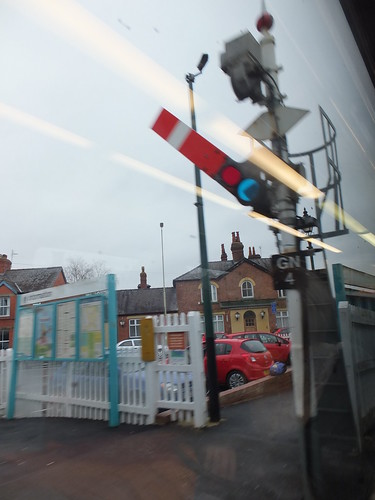
Gobowen North signal 'GN4'.
We paused briefly at Chirk (where I'd disembarked on my previous trip) and then crossed the Dee valley on the impressive viaduct. I'd forgotten how industrialised the area had once been around Ruabon and Brymbo with coal mines, heavy engineering and numerous railway branches to serve them. All gone now, of course.
Wrexham
Soon, we were running into Wrexham General. Logically, I would have stayed on my train until Chester, then caught a Merseyrail service to Birkenhead and Liverpool. There are a series of posts describing travelling on the Merseyrail network, starting with Birkenhead and New Brighton by train (Part 1).
However, my plan was to leave the train at Wrexham General, on the former Great Western Main line to Saltney Junction and Chester, take a few pictures and then travel forward to Bidston on the old Great Central line, now marketed as the 'Borderlands Line'. The Great Central Line ran through its own platforms at Wrexham General, to allow interchange, but then continued to its own station more conveniently sited in the town called Wrexham Central. I knew the remaining single line from Wrexham General to Wrexham Central now operated simply as a 'long siding'. I'd originally hoped to walk from Wrexham General to Wrexham Central, and catch the Bidston train from there but the late-running of the Holyhead train caused me to change my mind so I bought a ticket to Bidston at Wrexham General and settled for a few pictures around the Wrexham General station.
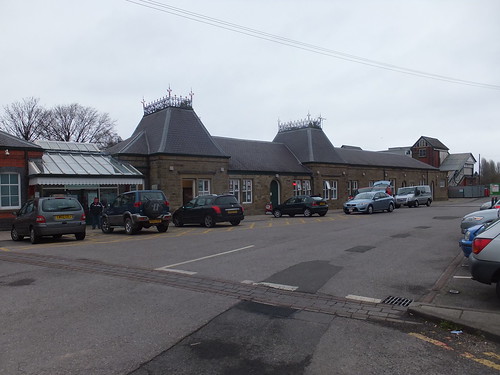 The neat appearance of the station buildings at Wrexham General.
The neat appearance of the station buildings at Wrexham General.
The trackwork around Wrexham General has been significantly simplified over the years and the only remaining signal box in the area is Croes Newydd North Fork Signal Box, a few hundred yards south of Wrexham General station.
 Croes Newydd North Fork Signal Box.
Croes Newydd North Fork Signal Box.
Having taken some pictures, I went to platform 4 which serves the Borderlands Line and found that the next arrival was going to Wrexham Central. A driver and guard were waiting to relieve the incoming crew. So, when the train arrived (a Class 150) I hopped on and got to ride to the very simple station platform at Wrexham Central (or Wrecsam Canolog, if you prefer), sandwiched between the modern buildings of a shopping centre. After a few moments, the driver and guard had changed ends, and we set off for Bidston.
 View of Wrexham Central station from the train.
View of Wrexham Central station from the train.
Borderlands Line
The Borderlands Line currently serves the following stations:-
Wrexham Central
Wrexham General
Gwersyllt
Cefn-y-Bedd
Caergwrle
Hope
Penyffordd
Buckley
Hawarden
Shotton High Level
Harwarden Bridge (peak periods only)
Neston
Heswall
Upton
Bidston
Although we were on a single line from Wrexham Central to Wrexham General (where the remains of the disused second platform could be seen), north of the station the original double track is retained. This seems curious, because the old Great Western main line from Wrexham to Saltney Junction has been singled (although there are plans to reinstate double track to increase capacity). I've never thought this singling very sound. In an earlier post Princes End I commented:-
At the time, there was also what seemed to me a rather perverse fashion for reducing track maintenance costs by singling double track sections. I was never convinced that this idea was justified, taking into account the signalling complication at each end of the single line where it rejoined normal double track and the operational problems of having to wait for a train in one direction to clear before a train could pass in the opposite direction.
I was quite surprised at the number of passengers we were dropping off and picking up along the line. Approaching Penyffordd, we whistled at three whistle boards in succession and then passed an upper quadrant tubular post distant showing 'off' before stopping at the station. The Home signal was also a tubular post, with a lower left-hand bracket and subsidiary signal controlling facing entry to sidings just after the B.R. standard signal box.
 Penyffordd signal box.
Penyffordd signal box.
The sidings didn't appear to be in use. A little further on, we passed a ground frame controlling access to another group of sidings. A branch curved away towards a modern cement plant but, again, there wasn't much sign that the rail connection was used.
The cement works (formerly Castle Cement but now Hanson, part of the Heidelberg Cement) is called Padeswood Works and there's a little more here. The massive Kiln 4 looks more like an assembly building for a Space Shuttle and its commissioning in 2005 allowed three older kilns on the site to be shut down. The owners proudly claim of Kiln 4:-
Central to the greatly improved performance is the use of alternative fuels, in which we have been a pioneer. Alternative fuels used at Padeswood include Cemfuel, which is processed from the residue of recycled waste solvents; Profuel, which comprises paper and plastic wastes and also MBM which is processed meat and bone meal. Vehicle tyres can also be used as an alternative fuel.
Buckley station has what would once have been an impressive station building, now derelict. Nearby, a well-maintained area had a wheelbarrow forming a planter filled with flowers. The wheelbarrow had been painted black and lettered 'LNER' as a reminder of the 'foreign' incursion into this part of Wales and was also chained to the nearby fence as a security precaution.
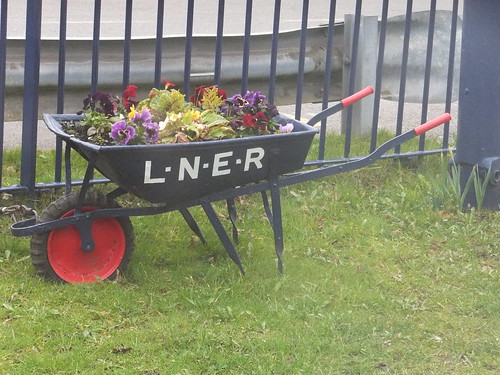 Flowers on Buckley station.
Flowers on Buckley station.
Hawarden station had the usual type of 'bus shelter' for passengers. Next, we took the bridge over the busy Chester Road in Shotton and paused at Shotton High Level station, which sported a rather up-market version of the 'bus shelter' featuring stainless steel. I was intrigued by a box of rodent bait set up on the platform ("Super rats eat stainless steel!" perhaps?). As we started away, we passed over the railway line to Holyhead and Shotton Low Level Station.
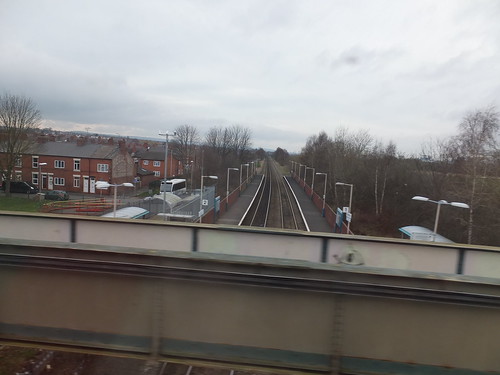 View of Shotton Low Level (looking towards Holyhead) from a Down Bidston train.
View of Shotton Low Level (looking towards Holyhead) from a Down Bidston train.
I'd previously travelled on the line from Shotton High Level to Bidston, years ago. This was the era when the North Wales Coast line had blue diesel-electrics hauling five blue and grey coaches (I think it was one of the last hunting grounds of the Class 40s). I travelled out from Chester to Shotton Low Level on one of these trains, took the footpath to high level and travelled to Bidston on a 'Modernisation' series Diesel Multiple Unit.
Passing through Shotton reminded me of a minor incident on another occasion years ago when I was off to Llandudno for the day - always a favorite destination as mentioned in posts A Trip to the Seaside (Part 1) and Part 2. Not all of the North Wales Coast line trains were booked to stop at Shotton Low Level but I'd noted that the early-morning service I'd chosen was due to stop. On the approach to Shotton, I thought my train was coming in rather 'hot' but then I realised the driver had forgotten the stop. I don't know whether the driver suddenly remembered or the guard 'put the brake in' but we did a rapid deceleration and came to a stop a couple of hundred yards beyond the platform. To my surprise, the train then gently set back to the platform and obediently waited for the guard's 'Right Away'.
Back in the present, as my Class 150 approached the Dee crossing, the sprawling Tata Steel complex came into view on the Wirral side. The history of steelmaking on this site is due to John Summers who, in 1852, established a successful nail making business in Stalybridge. After his death in 1876, three of his sons (later joined by a fourth) carried on the business. Needing space for expansion, they acquired land at Shotton in 1895 and Hawarden Bridge Steelworks opened the following year, later under the name John Summers and Sons Limited. In 1951, the steelworks was nationalised but shortly afterwards re-privatised. I think this is when I first became aware of Shotton's modern 'Integrated Steelworks' (where hot metal produced by a blast furnace is taken directly for processing into steel on the same site). The site was nationalised for a second time in 1967, becoming part of British Steel Corporation. In the 10-year plan for steel approved by the Government in 1973, Shotton was to lose its steelmaking as its blast furnace was regarded as too 'small batch' and its Open Hearth steelmaking as 'too expensive'. In-fighting with the Unions continued until 1980, and there was major local unemployment. To reduce unemployment, part of the site became Deeside Industrial Park. Some steelworking continued and in 1988 the British Steel Corporation was privatised as British Steel. In 1999, British Steel merged with the Dutch steelmaker Koninklijke Hoogovens to form Corus. Corus was acquired by the present owners, Tata Steel, in 2007 and Shotton is now responsible for their pre-finished steel products. There's a brief timeline produced by Tata Steel here.
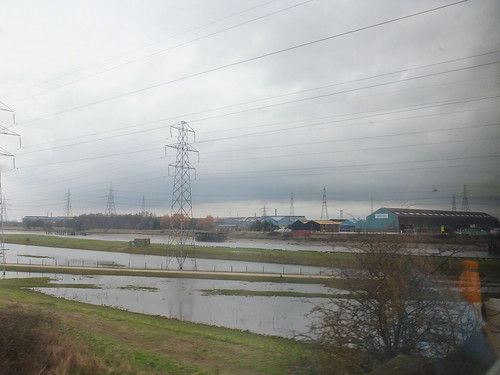 View from Down Bidston train approaching the Dee Crossing with the Tata Steel complex in the background.
View from Down Bidston train approaching the Dee Crossing with the Tata Steel complex in the background.
The double track railway (and a footpath) cross the Dee on a bridge of three spans of arched trusses. The span on the Wirral side was built as a hydraulically operated swing bridge but that's now welded shut. The bridge, opened in 1889 was built by the Manchester, Sheffield and Lincolnshire Railway (later the Great Central Railway). There's more information on the bridge in Chapter 10 of the Shotton History site here. It's only when I was compiling this post I found the Movable Bridges in the British Isles site, which also has some information on the bridge. Well, the view of the bridge I got was rather disappointing. I didn't realise Network Rail had started a 3.5 million pounds Sterling project to strengthen and repaint the bridge which is currently covered in scaffolding and heavy white plastic sheeting whilst sand-blasting to remove old paint is carried out. As the Network Rail News Release puts it, the bridge is "encapsulated to protect the environment from dust and debris from the work".
 Hawarden Bridge before "encapsulation" (Photo: John S. Turner, Creative Commons).
Hawarden Bridge before "encapsulation" (Photo: John S. Turner, Creative Commons).
Only certain trains stop at the tiny station of Hawarden Bridge, so we kept going and passed the signal box at Dee Marsh Jn. This once controlled one corner of a triangular junction with the Great Central Line to Chester which is long gone. Now, provided with a few elderly 2-aspect colour light signals, it controls connections to the extensive sidings around the steel complex.
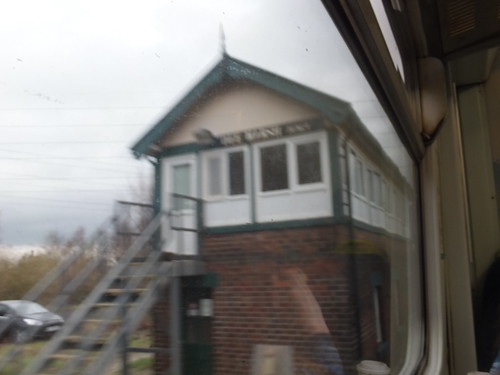 A fuzzy picture of Dee Marsh Junction signal box.
A fuzzy picture of Dee Marsh Junction signal box.
Although there were a few freight wagons scattered around the sidings, the area looks rather barren and neglected. Once we'd left the former steel complex behind, we made our way across the Wirral with stops at Neston, Heswall and Upton before our final destination at Bidston.
Bidston Station has a single island platform on the double-track third-rail electrified Merseyrail Line from Birkenhead North to West Kirby. With four trains an hour each way on the West Kirby line, the Borderlands Line trains have to sneak in out fairly quickly. Approaching Bidston from Wrexham, there's a facing crossover so, whenever possible, Sandhills Control Centre cross Borderlands Line trains into platform 2, and that's what happened to my train.
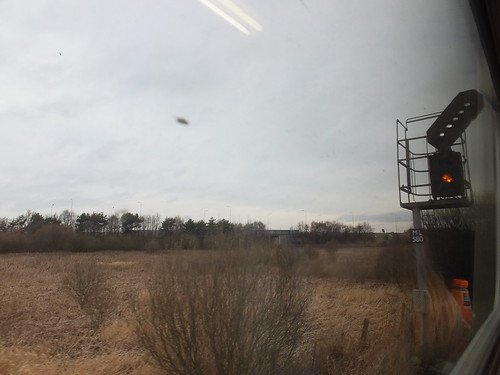 Approaching Bidston, my train gets a 'Yellow and a White Feather' for platform 2.
Approaching Bidston, my train gets a 'Yellow and a White Feather' for platform 2.
Running into platform 2 means that the train can arrive, crew can change ends, passengers get off and board and the train can depart without blocking platform 1 (the line towards Birkenhead) at all. Arriving in platform 1 fouls the line towards West Kirby until the train has arrived and the line towards Birkenhead is fouled until the train has drawn forward into the Stock Siding (part of a triangle which formerly allowed trains from West Kirby direct access to New Brighton). On leaving the Stock Siding, a trailing crossover allows Borderlands Line train into platform 2.
The not very pre-possessing station building actually has a decent waiting area, toilets and a small ticket office. By the time I'd bought my Merseyrail ticket to continue my travels, the Borderlands Line train had already left for Wrexham!
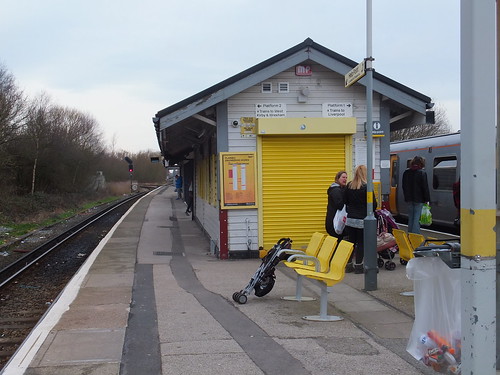 Bidston Station. The train I arrived on has already left platform 2 and a crowded electric train for Liverpool Central is arriving at platform 1.
Bidston Station. The train I arrived on has already left platform 2 and a crowded electric train for Liverpool Central is arriving at platform 1.
The rest of my journey is described in By rail to Liverpool (Part 2).
Book references
[1] 'Rail Centres: Shrewsbury' by Richard K. Morriss, published by Booklaw Publications (ISBN 1-901945-20-0).
[2] 'A Regional History of the Railways of Great Britain: Volume 11 North and Mid Wales by Peter E Baughan, published by David & Charles (ISBN 0-9153-7850-3).
Related articles on other sites
Wolverhampton to Shrewsbury Line (Wikipedia).
Shrewsbury to Chester Line (Wikipedia).
Borderlands Line (Wikipedia).
Borderlands Line.
Related posts on this site
By Rail to Chirk.
By rail to Liverpool (Part 2).
My pictures
Wolverhampton to Shrewsbury line.
Wellington.
Shrewsbury area railways.
Wrexham's Railways.
Borderlands Line.
Merseyrail.
[Link to part 2 added 5-Jun-2014]
Introduction
On 26th February 2014, I travelled from Wolverhampton to Chirk by rail in order to visit the Ty Gwyn woodland. There's a report on the visit here.
Wikipedia have some information on the line from Wolverhampton to Shrewsbury here and on the line beyond Shrewsbury to Chester here.
I've been familiar with the G.W.R. route from Wolverhampton to Shrewsbury and beyond since childhood. Back then, manual signal boxes with Absolute Block working controlled the route from Wolverhampton to Shrewsbury but over the years, one by one, they've been eliminated. I've continued to use the line to Shrewsbury and beyond intermittently for various trips.
Shrewsbury
I took an Arriva Trains Wales DMU from Wolverhampton to Shrewsbury, calling at Telford and Wellington. At Shrewsbury, I had a few minutes to take photographs before my connecting train to Chirk was due.
 The impressive station building on platform 3 features a tower flying the Union flag!
The impressive station building on platform 3 features a tower flying the Union flag!
There were plenty of people waiting to join the 3-coach Arriva Trains Wales service from Cardiff to Holyhead but we were soon on our way.
 Cardiff - Holyhead DMU arriving at Shrewsbury.
Cardiff - Holyhead DMU arriving at Shrewsbury.
Gobowen
After traversing a number of level crossings set in a fairly flat and rather wet landscape, we stopped at Gobowen. The station sports a Great Western railway nameboard 'GOBOWEN FOR OSWESTRY' (partly hidden behind the compulsory tall pole for mounting a CCTV camera). The currently-unused and rusty single line to Oswestry about 3 miles away is still intact and enthusiasts hope to re-open it, but the bay platform at Gobowen has lost its track.
 The nameboard hints at the station's former importance.
The nameboard hints at the station's former importance.
A further reminder of former better times is the rather attractive Italianate station building with a turret and stucco detailing, designed by locally-born Thomas Penson Junior and built around 1846 for the Shrewsbury and Chester railway. The building is now unused and available for sale or to rent. Wikipedia has more on the station here.
 The Down side former station building at Gobowen
The Down side former station building at Gobowen
Both the nameboard and the building are Grade II Listed:-
Railway station. Circa 1848 by Thomas Penson Jun. on the Shrewsbury and
Chester Railway with later additions and alterations. Stuccoed red brick
on moulded stone plinth; low-pitched hipped slate roofs have brick and ashlar
ridge stacks with moulded capping and dentilled cornices. Italianate style.
2 storeys. Entrance side has 3-storey rectangular tower projecting to right
with finial to low-pitched pyramidal roof and modillioned eaves cornice.
'Belfry' has blind round-headed arches with balustrade. 2-bay centre section
has round-headed sash windows to first floor, paired to right, with continuous
moulded impost bands and interlacing wheel decoration to aprons. Glazing
bar sashes in lugged architraves to ground floor. Projecting left range
has paired round-headed sash windows to first floor. Tall double doors
to centre approached by flight of 3 steps and flanked by round-arched sash
windows. Single-storey exedra to left with dentilled cornice and 4-paned
sashes in lugged architraves. Platform side has bracketed canopy, removed
at time of resurvey (April 1986) to top end of platform but continued, supported
by cast-iron columns, to south; cusped quatrefoils to spandrels of brackets.
Footbridge linking down-line side with up-line side has latticed cast-iron
girders to covered walk-way. Single-storey yellow brick range to up-
line side with round-arched sash windows and doorways; ornamental cast-iron
brackets supporting canopy. Later platform canopy to south of footbridge.
Station name-boardslettered "GOBOWEN / FOR / OSWESTRY" between cast-iron
columns with moulded capping at north end of up -line platform and south
end of down-line platform. Extensive restoration was in progress at time
of resurvey (April 1986).
See the British Listed Buildings entry here.
Chirk
The next stop was Chirk, where I alighted and continued by road. The tiny station is looked after and kept attractive by local support.
 Chirk Station.
Chirk Station.
Chirk is dominated by the huge Kronospan factory. Kronospan claim to be the world’s largest manufacturer of wood panel products and laminate flooring. Worldwide, it has more than 30 manufacturing sites. There's more information here.
 View of the Kronospan plant from Chirk Station car park.
View of the Kronospan plant from Chirk Station car park.
Returning from Chirk
Later in the day, I was back at Chirk station for the return journey. I'd forgotten, until I saw a plaque on the station, that Chirk was the end of the Glyn Valley Tramway, opened in 1873, finally closed in 1935. There's a 'Wikipedia' article here. The New Glyn Valley Tramway & Industrial Heritage Trust are seeking to conserve, research and interpret the Industrial Heritage of the area and Glyn Valley Tramway and have experimentally laid a length of track to the tramway's odd 2ft 4½in track gauge. The Glyn Valley Tramway Trust are separately pursuing similar aims.
 Glyn Valley Tramway Plaque, Chirk station.
Glyn Valley Tramway Plaque, Chirk station.
The 3-car DMU which I took back to Shrewsbury was going through to Maesteg.
 The Maesteg train arriving at Chirk.
The Maesteg train arriving at Chirk.
Passing through Shrewsbury
I was quite tired by the time we arrived at Shrewsbury (after spending a few hours romping round the woodland in the rain earlier) so I was relieved to be able to get on my connecting train back to Wolverhampton. The late afternoon sun improved my picture of Severn Bridge Jn. signal box. I noticed that the 3-aspect colour light in the foreground of my shot now sports a blue GSM-R plate. The world is changing!
 The monolithic bulk of Severn Bridge Junction, with a 3-aspect colour light in the foreground.
The monolithic bulk of Severn Bridge Junction, with a 3-aspect colour light in the foreground.
Book references
[1] 'Rail Centres: Shrewsbury' by Richard K. Morriss, published by Booklaw Publications (ISBN 1-901945-20-0).
[2] 'A Regional History of the Railways of Great Britain: Volume 11 North and Mid Wales by Peter E Baughan, published by David & Charles (ISBN 0-9153-7850-3).
Related articles on other sites
Wolverhampton to Shrewsbury Line (Wikipedia).
Shrewsbury to Chester Line (Wikipedia).
Glyn Valley Tramway (Wikipedia).
My pictures
Wolverhampton to Shrewsbury line.
Wellington.
Shrewsbury area railways.
In a couple of earlier posts (Winter Timetable at Peak Rail and Peak Rail in early 2014) I've described the winter operations between Rowsley and Matlock Riverside. In March 2014, we changed to the Summer timetable, with five round trips top-and-tailed between Rowsley and Matlock Town.
My first turn was during March was on Sunday, the 2nd. However, we were running a special timetable that day because a main line HST Charter train from St. Pancras was scheduled. Originally marketed in the 1970s as 'Inter City 125' trains, these High Speed diesel-electric trains are still in widespread use on mainline services.
Phil and I had 'Lord Phil', facing north. We came off shed nice and early so as to start warming our 7-coach train. The advantage of being at the north end was the relative ease of taking water during the day from the 4-wheel long wheelbase petrol tank wagon just off the north end of the platform, compared with the exhausting business of dragging a long canvas water hose around when watering from the tank wagon at the south end of Rowsley station.
 'Penyghent' coming 'off-shed' to work the 10:20 service train to Matlock Town.
'Penyghent' coming 'off-shed' to work the 10:20 service train to Matlock Town.
A few minutes late, 'Penyghent' came 'off-shed' and 'hooked on' at the south end of the train ready for the first of six round trips we were booked to run to Matlock Town that day. The guard gave the 'Right Away' and 'Penyghent' took the train to our first stop at Darley Dale. With D8 on the front and seven coaches, 'Lord Phil' was well short of the platform when we stopped. I made a careful note of our position by placing three small lumps of coal on the sleeper end of the Down Line opposite our cab. Then, we carried on to Matlock Town. There wasn't much chance to make up list time because the track has recently been slewed approaching Matlock Riverside and a temporary speed limit of 10 m.p.h. has been imposed.
At Matlock Town, 'Penyghent' surrendered the single line staff to us for the journey back to Darley Dale, this time with 'Lord Phil' doing the work.
At Darley Dale, the fireman surrendered the staff to the signalman and I carefully drew the train through the platform and stopped with the engine cab level with the three small lumps of coal. Obviously, I had to ensure that the whole train, including 'Penyghent', had been drawn clear of the level crossing so that the gates could be opened to road traffic. But there's another constraint. In the post Peak Rail in early 2014 I talked about stopping 'behind' a signal and said "In some cases, track circuits are provided to indicate to the signalman the position of vehicles and electric locking may prevent the changing of points unless the movement is correctly standing 'behind' the signal". The Down platform at Darley Dale is such a case. Unless the whole train was 'behind' the ground signal, we would still be occupying the track circuit and the facing points could not be changed. This doesn't matter too much if there's only one train but, later in the day, I'd need to stop our train in this position to allow the HST Charter to return to Matlock. Stopping in the wrong place for this one would have made me very unpopular! Fortunately, all was well.

View of Midland Railway 'dwarf' shunting signal on the Down Main at Darley Dale, looking towards Matlock.
I stopped 'right' at Rowsley, allowing us to take water without difficulty. Although we were only working the train in one direction, we were providing steam heating for seven coaches, so we were boiling a fair amount of water.
The second departure from Rowsley was booked to stand at Darley Dale and wait for the HST Charter to pass on its way to Rowsley. Telephone messages informed station staff that the HST Charter was 'on time' and before long we heard the horn of the approaching train.

A cluster of photographers on the Down Platform at Darley Dale to record the HST.
The HST made its stately passage through the station on the Down line and, after a few minutes, we continued to Matlock Riverside. Phil drove the return journey back to Rowsley, stopping accurately at Darley Dale and Rowsley, where we watered again. The HST had parked itself neatly on the loop at Rowsley, out of our way.
 Phil takes the train back to Rowsley.
Phil takes the train back to Rowsley.
I think there were around 400 passengers on the HST Charter and many of them took a trip to Matlock Town on the service train. There were sales stands on Rowsley platform and the various preservation groups around the Rowsley site were welcoming the visitors. I was particularly taken with the project to build a full-size re-creation of Ivatt's prototype L.M.S. diesel electric '10000' - their website is here. Unfortunately, the weather deteriorated at this stage and we were all rather wet and windswept.
On our fourth round trip, we were booked to stand in the Down platform at Darley Dale, to allow the HST Charter to pass on its way back to St. Pancras. I walked across to the Up platform to take a few pictures.
 The HST passes 'Lord Phil' in Darley Dale.
The HST passes 'Lord Phil' in Darley Dale.
We completed our journey to Rowsley, plus two more round trips, by which time we were quite ready to go on shed and dispose, concluding a most interesting day.
HST Gallery
 The Australian version (the 'XPT') pictured in Sydney in 2001.
The Australian version (the 'XPT') pictured in Sydney in 2001.
 East Midlands Trains HST at Leicester in 2009.
East Midlands Trains HST at Leicester in 2009.
 'East Coast' liveried HST viewed from King's Cross Power Signal Box in 2009.
'East Coast' liveried HST viewed from King's Cross Power Signal Box in 2009.
 First Great Western HST at Bath Spa in 2013.
First Great Western HST at Bath Spa in 2013.
 East Midlands Trains HST at Sheffield in 2013.
East Midlands Trains HST at Sheffield in 2013.
Book references
'Inter City 125' by R. M. Tufnell published by Haynes Publishing Group (ISBN 0 85429 428 7).
Related articles on other sites
British Rail Class 43 (HST) (Wikipedia).
Inter City 125 (Wikipedia).
125 Group
Related posts in this blog
D8 'Penyghent'
My pictures
HST Charter to Peak Rail.
'Lord Phil'.
'Penyghent'.

 The Waterloo Place facade of the Lyceum.
The Waterloo Place facade of the Lyceum.
 Victoria Memorial, Derby Square.
Victoria Memorial, Derby Square.
 Looking down James Street, the black glass of the modern developments highlights the clean lines of the Mersey Railway Pumping Station, still at work.
Looking down James Street, the black glass of the modern developments highlights the clean lines of the Mersey Railway Pumping Station, still at work.

 'Lion' on display in the Great Port Gallery, with the Liverpool Overhead Railway coach in the background.
'Lion' on display in the Great Port Gallery, with the Liverpool Overhead Railway coach in the background.
 The Museum of Liverpool shortly before opening to the public in 2011 - "Fourth Grace" or "Dented Shoebox"?
The Museum of Liverpool shortly before opening to the public in 2011 - "Fourth Grace" or "Dented Shoebox"?
 Mersey Ferry 'Snowdrop' approaching Pierhead.
Mersey Ferry 'Snowdrop' approaching Pierhead.


 Isle of Man ferry 'Ben-My-Chree'.
Isle of Man ferry 'Ben-My-Chree'.
 Birkenhead: Pumphouse with 'The Giant Grasshopper' pump.
Birkenhead: Pumphouse with 'The Giant Grasshopper' pump.

 Port Sunlight, showing varying building styles.
Port Sunlight, showing varying building styles.
 The Main entrance to the Lady Lever Art Gallery.
The Main entrance to the Lady Lever Art Gallery.

 'Environs of Chester & Wrexham' from the 11th Edition of the Pre-Grouping 'Railway Map of England and Wales' published by W & A K Johnston.
'Environs of Chester & Wrexham' from the 11th Edition of the Pre-Grouping 'Railway Map of England and Wales' published by W & A K Johnston.

















